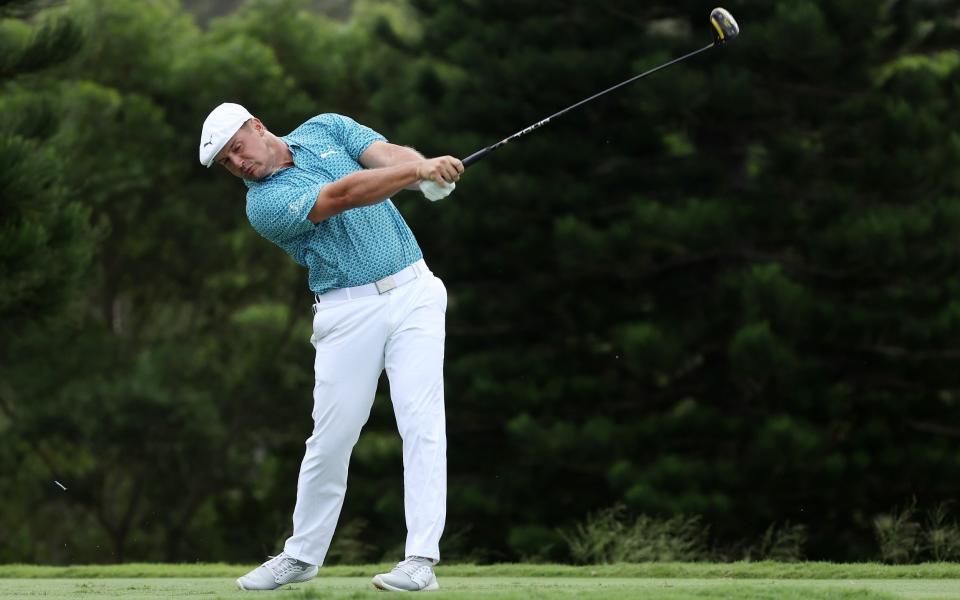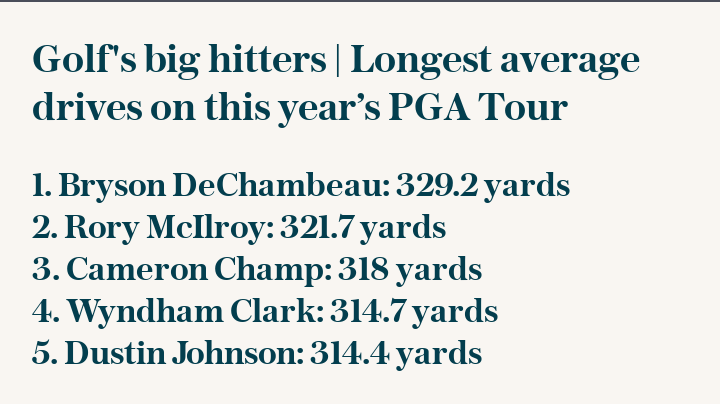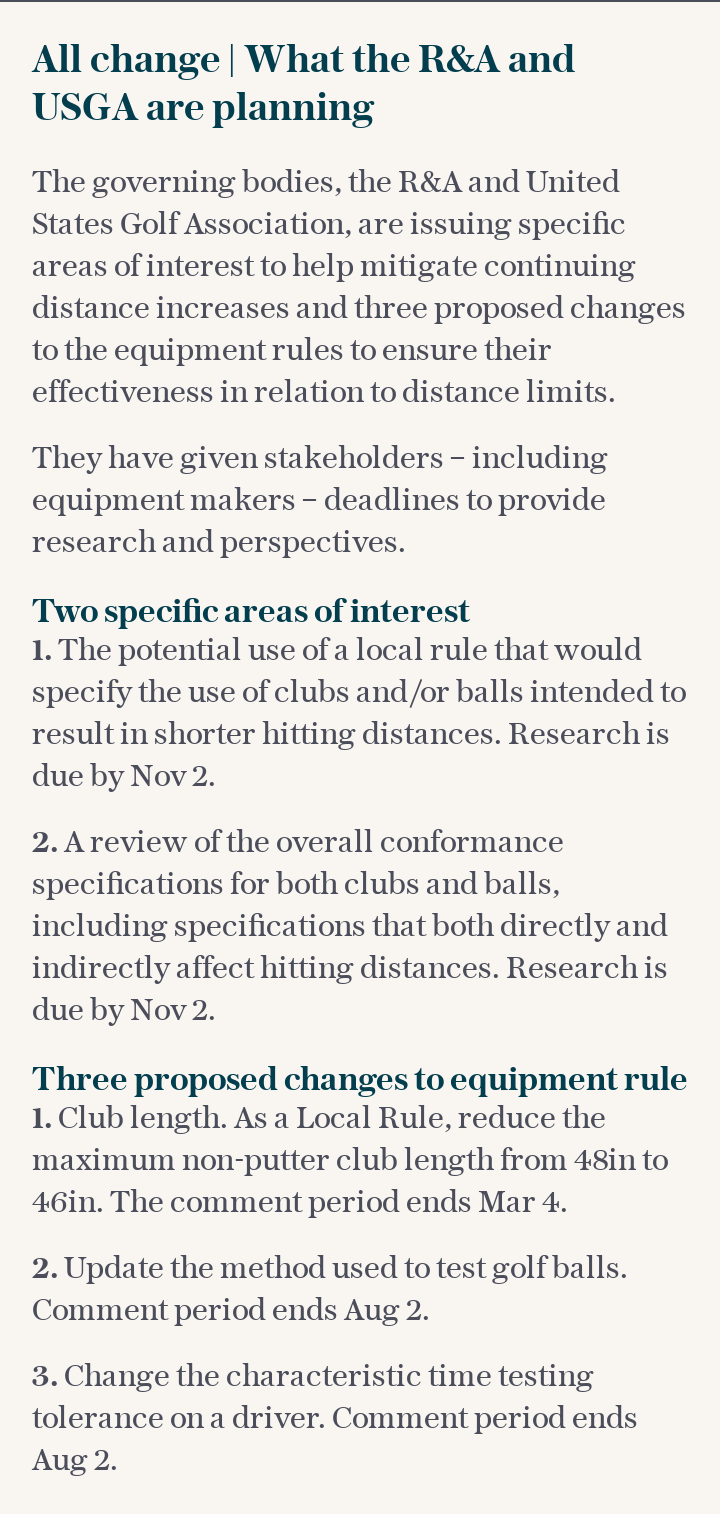Reining in the big hitters: Golf's governing bodies take steps to tackle game's distance problem

Golf’s leading authorities signalled their intention to rescue the future of the sport from the big hitters on Tuesday by unveiling proposals to rein in the likes of Bryson DeChambeau and Rory McIlroy.
The game’s two governing bodies, the R&A and the US Golf Association, have paved the way for restrictions on equipment including limits on the length of drivers and the introduction of a standardised, tournament ball on the tours.
The move is likely to leave DeChambeau’s plan to employ a 48-inch driver to overpower Augusta National at the Masters in April in tatters.
It was the landmark day for which the purists – including the likes of Jack Nicklaus and Tiger Woods – had been waiting since the powers that be signalled last February that, with the “Distance Insights” project, they were ready at last to tackle the professional game’s length issue that their joint studies indicated was “critical to the future of the game”.
The pandemic pressed pause on the progress, but it has resumed and has at last reached what is labelled the “solution phase”. With Martin Slumbers, the R&A chief executive, confirming to Telegraph Sport on Tuesday that a radical overhaul of the professional game was all but inevitable – “it is highly unlikely that we will end up doing nothing” – it will now start collecting feedback regarding the potential use of a local rule that specifies the use of clubs and balls intended to result in shorter hitting distances. In the short term, comments have been sought on the proposal to introduce a local rule reducing the maximum non-putter club length from 48in to 46in.
The deadline for this is March 4 and, as it is expected to go through, it will allow Augusta and every other tournament organiser to put a brake on the long hitters. Slumbers denied it was “individual specific”, but accepted that the big hitters out there could be “personalised in this”.
Yet the big battle will surely come in the attempts of the R&A and USGA to persuade the equipment makers to review the overall conformance specifications for clubs and balls, including specifications that directly affect hitting distances. This means the ruling bodies want to research topics such as the limitation of ball efficiency, ball sizes and weights, making drivers smaller in volume and shorter, and reducing the spring-like effect in faces and moment of inertia in club heads.
They have chosen to go down the “local rule” to ensure that golf continues to have one set of rules to which professionals and amateurs of all grades will adhere. “Local rules” are not part of the official rule book, but are a modification or addition of a rule that any tournament committee can adopt for a particular competition.
The rules would, in fact, be different in practice and it would ultimately mean that, while the weekend hacker would still be able to use the best technology can offer – there is no appetite to alter things significantly at recreational level – the pros will face game-changing restrictions.
Slumbers, though, does not see it that way. “The local rule could be applied on a much wider scale than the pro game, or the elite amateur game,” he said. “I think it’s misleading to say it is just about elite golf.”
No doubt the lawyers will become, and are already involved, with the equipment makers desperate to protect their billion-dollar industry, but the hope is that agreement can be reached following the conclusion of the feedback stage in November. “This is a serious problem and this is the time for serious thinking and I am confident the game and its many facets can come together to do what is right for our sport,” Slumbers said.
It is a complex subject, but Slumbers pointed out that, while they intend the conversations to be as in-depth as they are responsible, they should not drag on. The likes of DeChambeau are already threatening the 400-yard mark and there is an urgency to curtail the bombers to ensure great courses do not become obsolete and that the game does not become too one-dimensional.
“There is the balance of skill and technology that we are trying to find because the game is in danger of losing that balance,” Slumbers said. “After the lockdown, the different tours, governing bodies, golf federations, golf unions and bodies such as Augusta and the PGA of America came together to ensure the sport could get back and running as effectively as possible. That gives me confidence in this regard.”
Mike Davis, Slumbers’s counterpart at the USGA, added: “This is about long term, for the whole of the game. Golfers need to understand that this every-generation-hits-the- ball-farther is affecting the game negatively. The cost of this is being born by all golfers. We’re just trying to fit the game of golf back on golf courses.”
'Local rule' route perfect plan to thwart big hitters
The R&A and United States Golf Association are far from stupid and are acutely aware that they will have a fight on their hands with the equipment makers with their proposals to reduce the hitting distances in the professional game.
Yet if they were expecting this essentially to be a battle with the bombers on Tour, then Webb Simpson highlighted that even the plotters could be in opposition.
Simpson, the world No 9, is one of the shorter hitters in the elite, standing at 114th in the PGA Tour’s driving distance stats, having failed to finish in the top 100 in the past six seasons.
If the power of Dustin Johnson, Bryson DeChambeau and Rory McIlroy was suddenly curtailed, it would surely have to be good for Simpson’s chances of adding to the one major on his resume.

But, as if to prove the depth of feeling to the sponsors who have paid these performers multi-millions in the Tiger Woods era, Simpson was yesterday far from welcoming about the proposals, which include cutting down the maximum length of driver shafts and setting limits on clubs and balls.
“I don’t think an equipment rollback is what we need – I think we need to tweak our golf courses,” he said before coming up with all sorts of absurd ideas to protect great holes.
On the 13th at Augusta – the celebrated par-five where the green-jackets are loath to continue to push back the tee – Simpson would simply put “a mid-sized tree 20 yards in front of the tee box and five yards to the left”. No doubt, that would stop the boom merchants, although in the process it would also ruin the characteristics of one of the sport’s greatest holes.
Martin Slumbers and Mike Davis, the respective leaders at the R&A and USGA, had better be prepared to listen to such nonsense in this 10-month consultation period. Their in-trays will be full and the threats will come from the legal teams, who are already out there ready and billing.
But they must keep their nerve and stick to the process they have set out, regardless of what the PGA Tour and its superstars might say. Because once they get there, they will hold all the aces.
The “local rule” route is clever on a few fronts. For starters, they can counter the claims of the anti-bifurcation lobby, who think it is sacrilege to have one set of rules for the pros and another for the amateurs. This way, the official rule book will remain the same for both; it will simply mean that the tournament committees can decide to utilise the local rule specifying certain restrictions on clubs and balls for their competitions.
There will be nothing stopping normal golf clubs for using the local rule if they choose. They will not, because it would be ludicrous to put the brakes on hackers who need all the help they can muster.
The majors will definitely employ the local rule and that is the genius of it.
The Masters is on board, and has already stated its desire for some action from the two governing bodies, and the R&A and USGA happen to run the Open and US Open.
That leaves the PGA of America, custodians of the US PGA. There is no way that they would be the odd major out.
Of course, the PGA Tour could carry on with the status quo, but with the game’s most important events going local, how long would they last operating under different conditions? Not long. The professionals would not allow it.
It will be intriguing to see how the women’s game reacts, because there is not a distance issue there. Eventually, due to cost, every strand of the sport will fall into line, with new, agreed specifications for balls and clubs, and golf will prosper yet further.
Big hitting can be entertaining and there is a definite wow factor when Johnson, DeChambeau and McIlroy walk on to the tee. But it has a flip side, not least with the game becoming too one-dimensional and the art of shot-shaping being forsaken.
Courses are having to be made longer, causing more expense, greater environmental concerns and making rounds interminably slow.
The equipment rollback will take a while to get right and there will be many bumps along the fairway. But when the game reaches its 19th hole, it will, as ever, seem more than worth it.


